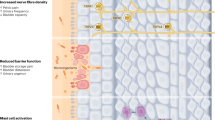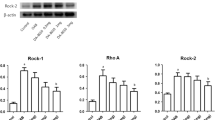Abstract
The role of nitric oxide (NO) in the pathophysiology of lower urinary tract symptoms (LUTS), detrusor overactivity (DO), and overactive bladder symptoms does not seem to be established. As demonstrated in animal models, interference with the NO/cyclic guanosine monophosphate (cGMP)/cGMP-dependent protein kinase (PKG) pathway at any level (NO synthesis, soluble guanylate cyclase, cGMP, PKG) will lead to DO. One important factor influencing the bladder NO/cGMP/PKG pathway is oxidative stress, in which an abnormal level of reactive oxygen species (ROS) causes tissue damage. ROS may be involved in several bladder pathologies known to show LUTS/DO in animal models, including bladder outlet obstruction, ischemia/reperfusion, and inflammation. The role of ROS in the generation of storage LUTS (including overactive bladder), has not been clarified, though it seems to involve the NO/cGMP/PKG pathway and other mechanisms. To gain further insights into this important field of investigation, new animal models are required to define potential targets for future therapeutic interventions.
Similar content being viewed by others
References
Papers of particular interest, published recently, have been highlighted as: • Of importance
Andersson KE: Storage and voiding symptoms: pathophysiologic aspects. Urology 2003, 62(5 Suppl 2):3–10.
Andersson KE: LUTS treatment: future treatment options. Neurourol Urodyn 2007, 26(6 Suppl):934–947.
Gao Y: The multiple actions of NO. Pflugers Arch 2009 Dec 19 (Epub ahead of print).
Andersson KE, Wein AJ: Pharmacology of the lower urinary tract: basis for current and future treatments of urinary incontinence. Pharmacol Rev 2004, 56:581–631.
Parekh MH, Lobel RO, Connor LJ, et al.: Protective effect of vitamin E on the response of the rabbit bladder to partial outlet obstruction. J Urol 2001, 166:341–346.
Chien CT, Yu HJ, Lin TB, et al.: Substance P via NK1 receptor facilitates hyperactive bladder afferent signaling via action of ROS. Am J Physiol Renal Physiol 2003, 284:F840–F851.
Chien WC, Hayakawa S, Shimizu K, et al.: Catechins prevents substance P-induced hyperactive bladder in rats via the downregulation of ICAM and ROS. Neurosci Lett 2004, 367:213–217.
Yu HJ, Chien CT, Lai YJ, et al.: Hypoxia preconditioning attenuates bladder overdistension-induced oxidative injury by up-regulation of Bcl-2 in the rat. J Physiol 2003, 554:815–828.
Erdem E, Leggett R, Dicks B, et al.: Effects of bladder ischaemia/reperfusion on superoxide dismutase activity and contraction. BJU Int 2005, 96:169–174.
Lin AT, Yang CH, Chen KK, Chang LS: Detrusor mitochondrial lipid peroxidation and superoxide dismutase activity in partial bladder outlet obstruction of rabbits. Neurourol Urodyn 2005, 24:282–287.
Juan YS, Lin WY, Kalorin C, et al.: The effect of partial bladder outlet obstruction on carbonyl and nitrotyrosine distribution in rabbit bladder. Urology 2007, 70:1249–1253.
Irwin DE, Milsom I, Hunskaar S, et al.: Population-based survey of urinary incontinence, overactive bladder, and other lower urinary tract symptoms in five countries: results of the EPIC study. Eur Urol 2006, 50:1306–1314; discussion 1314–1315.
Coyne KS, Sexton CC, Thompson CL, et al.: The prevalence of lower urinary tract symptoms (LUTS) in the USA, the UK and Sweden: results from the Epidemiology of LUTS (EpiLUTS) study. BJU Int 2009, 104:352–360.
Irwin DE, Milsom I, Kopp Z, et al.: Prevalence, severity, and symptom bother of lower urinary tract symptoms among men in the EPIC study: impact of overactive bladder. Eur Urol 2009, 56:14–20.
Heidler S, Deveza C, Temml C, et al.: The natural history of lower urinary tract symptoms in females: analysis of a health screening project. Eur Urol 2007, 52:1744–1750.
Lemack GE: Assessing the natural history of lower urinary tract symptoms without incontinence in women: what have we learned and where are we headed? Eur Urol 2007, 52:1576–1578.
Lee AJ, Garraway WM, Simpson RJ, et al.: The natural history of untreated lower urinary tract symptoms in middle-aged and elderly men over a period of five years. Eur Urol 1998, 34:325–332.
Temml C, Brossner C, Schatzl G, et al.: The natural history of lower urinary tract symptoms over five years. Eur Urol 2003, 43:374–380.
Garnett S, Swithinbank L, Ellis-Jones J, Abrams P: The long-term natural history of overactive bladder symptoms due to idiopathic detrusor overactivity in women. BJU Int 2009, 104:948–953.
Abdel-Aziz KF, Lemack GE: Overactive bladder in the male patient: bladder, outlet, or both? Curr Urol Rep 2002, 3:445–451.
Siroky MB: Lower urinary tract symptoms: shifting our focus from the prostate to the bladder. J Urol 2004, 172:1237–1238.
Chapple CR, Roehrborn CG: A shifted paradigm for the further understanding, evaluation, and treatment of lower urinary tract symptoms in men: focus on the bladder. Eur Urol 2006, 49:651–659.
• Roosen A, Chapple CR, Dmochowski RR, et al.: A refocus on the bladder as the originator of storage lower urinary tract symptoms: a systematic review of the latest literature. Eur Urol 2009 Aug 4 (Epub ahead of print). This is a comprehensive review on the pathophysiology of storage LUTS.
Chapple CR, Wein AJ, Abrams P, et al.: Lower urinary tract symptoms revisited: a broader clinical perspective. Eur Urol 2008, 54:563–569.
Andersson KE: Detrusor myocyte activity and afferent signaling. Neurourol Urodyn 2010, 29:97–106.
• Gillespie JI, van Koeveringe GA, de Wachter SG, de Vente J: On the origins of the sensory output from the bladder: the concept of afferent noise. BJU Int 2009, 103:1324–1333. This is a timely update on afferent signaling from the bladder.
Andersson KE: Bladder activation: afferent mechanisms. Urology 2002, 59(5 Suppl 1):43–50.
de Groat WC: The urothelium in overactive bladder: passive bystander or active participant? Urology 2004, 64(6 Suppl 1):7–11.
Birder LA, de Groat WC: Mechanisms of disease: involvement of the urothelium in bladder dysfunction. Nat Clin Pract Urol 2007, 4:46–54.
Birder LA, Wolf-Johnston AS, Chib MK, et al.: Beyond neurons: involvement of urothelial and glial cells in bladder function. Neurourol Urodyn 2010, 29:88–96.
Ikeda Y, Kanai A: Urotheliogenic modulation of intrinsic activity in spinal cord-transected rat bladders: role of mucosal muscarinic receptors. Am J Physiol Renal Physiol 2008, 295:F454–F461.
de Groat WC: A neurologic basis for the overactive bladder. Urology 1997, 50(6A Suppl):36–52.
Fowler CJ, Griffiths D, de Groat WC: The neural control of micturition. Nat Rev Neurosci 2008, 9:453–466.
de Groat WC, Kawatani M, Hisamitsu T, et al.: Mechanisms underlying the recovery of urinary bladder function following spinal cord injury. J Auton Nerv Syst 1990, 30(Suppl):S71–S77.
de Groat WC, Yoshimura N: Changes in afferent activity after spinal cord injury. Neurourol Urodyn 2010, 29:63–76.
Seki S, Sasaki K, Igawa Y, et al.: Suppression of detrusor-sphincter dyssynergia by immunoneutralization of nerve growth factor in lumbosacral spinal cord in spinal cord injured rats. J Urol 2004, 171:478–482.
Seki S, Sasaki K, Fraser MO, et al.: Immunoneutralization of nerve growth factor in lumbosacral spinal cord reduces bladder hyperreflexia in spinal cord injured rats. J Urol 2002, 168:2269–2274.
Vizzard MA: Neurochemical plasticity and the role of neurotrophic factors in bladder reflex pathways after spinal cord injury. Prog Brain Res 2006, 152:97–115.
Andersson KE, Arner A: Urinary bladder contraction and relaxation: physiology and pathophysiology. Physiol Rev 2004, 84:935–986.
Marletta MA: Nitric oxide synthase structure and mechanism. J Biol Chem 1993, 268:12231–12234.
Felsen D, Dardashti K, Ostad M, et al.: Inducible nitric oxide synthase promotes pathophysiological consequences of experimental bladder outlet obstruction. J Urol 2003, 169:1569–1572.
Masuda H, Kawano K, Matsuoka Y, et al.: Interactions between inducible nitric oxide synthase and cyclooxygenase-2 in response to ischaemia-reperfusion of rabbit bladder. BJU Int 2009 Dec 18 (Epub ahead of print).
Andersson KE, Persson K: Nitric oxide synthase and the lower urinary tract: possible implications for physiology and pathophysiology. Scand J Urol Nephrol Suppl 1995, 175:43–53.
Birder LA, Apodaca G, De Groat WC, Kanai AJ: Adrenergic- and capsaicin-evoked nitric oxide release from urothelium and afferent nerves in urinary bladder. Am J Physiol 1998, 275:F226–F229.
Birder LA, Nealen ML, Kiss S, et al.: Beta-adrenoceptor agonists stimulate endothelial nitric oxide synthase in rat urinary bladder urothelial cells. J Neurosci 2002, 22:8063–8070.
Pandita RK, Mizusawa H, Andersson KE: Intravesical oxyhemoglobin initiates bladder overactivity in conscious, normal rats. J Urol 2000, 164:545–550.
Ozawa H, Chancellor MB, Jung SY, et al.: Effect of intravesical nitric oxide therapy on cyclophosphamide-induced cystitis. J Urol 1999, 162:2211–2216.
Korkmaz A, Oter S, Sadir S, et al.: Peroxynitrite may be involved in bladder damage caused by cyclophosphamide in rats. J Urol 2005, 173:1793–1796.
Masuda H, Kihara K, Saito K, et al.: Reactive oxygen species mediate detrusor overactivity via sensitization of afferent pathway in the bladder of anaesthetized rats. BJU Int 2008, 101:775–780.
Johansson R, Pandita RK, Poljakovic M, et al.: Activity and expression of nitric oxide synthase in the hypertrophied rat bladder and the effect of nitric oxide on bladder smooth muscle growth. J Urol 2002, 168:2689–2694.
Aikawa K, Leggett RE, Levin RM: Effect of age on hydrogen peroxide mediated contraction damage in the male rat bladder. J Urol 2003, 170:2082–2085.
Huie RE, Padmaja S: The reaction of NO with superoxide. Free Radic Res Commun 1993, 18:195–199.
Nishikawa T, Edelstein D, Du XL, et al.: Normalizing mitochondrial superoxide production blocks three pathways of hyperglycaemic damage. Nature 2000, 404:787–790.
Brownlee M: The pathobiology of diabetic complications: a unifying mechanism. Diabetes 2005, 54:1615–1625.
Brownlee M: Biochemistry and molecular cell biology of diabetic complications. Nature 2001, 414:813–820.
Friederich M, Hansell P, Palm F: Diabetes, oxidative stress, nitric oxide and mitochondria function. Curr Diabetes Rev 2009, 5:120–144.
Beshay E, Carrier S: Oxidative stress plays a role in diabetes-induced bladder dysfunction in a rat model. Urology 2004, 64:1062–1067.
Tuttle JB: New tools to study bladder dysfunction. J Urol 2010, 183:423–424.
Lu B, Poirier C, Gaspar T, et al.: A mutation in the inner mitochondrial membrane peptidase 2-like gene (Immp2l) affects mitochondrial function and impairs fertility in mice. Biol Reprod 2008, 78:601–610.
• Soler R, Füllhase C, Lu B, et al.: Bladder dysfunction in a new mutant mouse model with increased superoxide—lack of nitric oxide? J Urol 2010, 183:780–785. This article presents new aspects of superoxide-induced bladder dysfunction.
de Jongh R, Haenen GR, van Koeveringe GA, et al.: Oxidative stress reduces the muscarinic receptor function in the urinary bladder. Neurourol Urodyn 2007, 26:302–308.
Wynn TA: Cellular and molecular mechanisms of fibrosis. J Pathol 2008, 214:199–210.
Disclosure
No potential conflicts of interest relevant to this article were reported.
Author information
Authors and Affiliations
Corresponding author
Rights and permissions
About this article
Cite this article
Andersson, KE., Fullhase, C., Soler, R. et al. Update on Uropharmacology: Bladder Dysfunction, Nitric Oxide, and Reactive Oxygen Species. Curr Bladder Dysfunct Rep 5, 150–156 (2010). https://doi.org/10.1007/s11884-010-0057-4
Published:
Issue Date:
DOI: https://doi.org/10.1007/s11884-010-0057-4




